Travel photography captures unique moments and stories from around the world. Essential gear includes a quality camera, versatile lenses, and protective bags. Techniques like composition and lighting improve image quality. Understanding cultural context fosters respectful interactions and enhances storytelling.
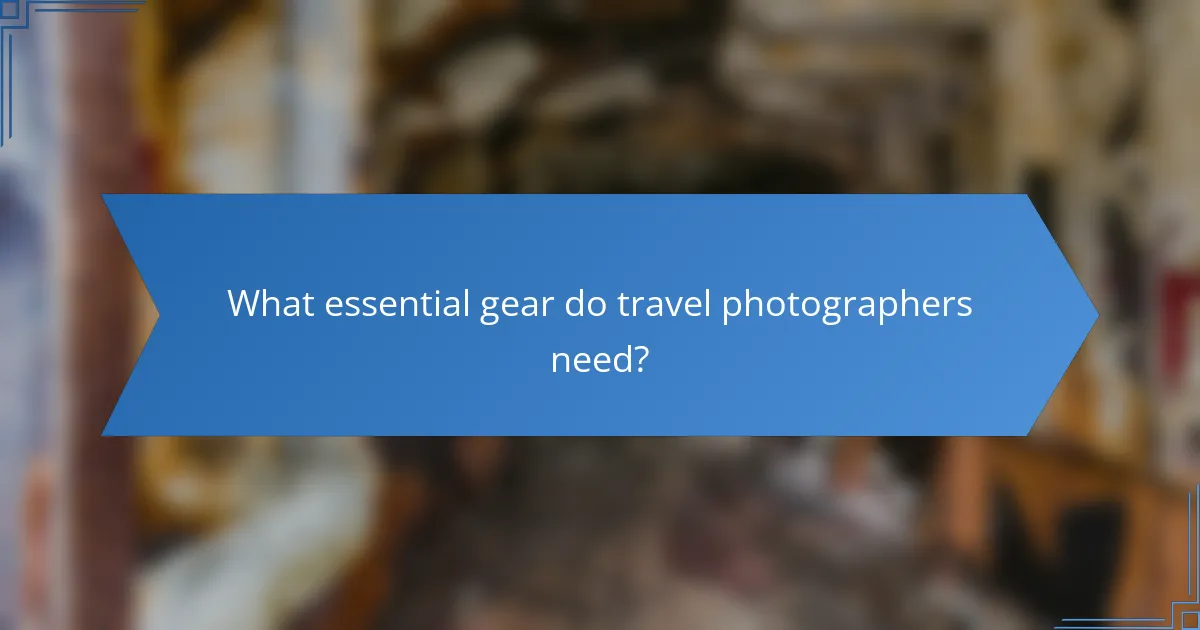
What essential gear do travel photographers need?
Travel photographers need a camera, versatile lenses, a sturdy tripod, extra batteries, memory cards, and a weatherproof bag. These essentials enhance image quality and ensure preparedness for various conditions. A full-frame camera offers superior image quality, while a lightweight tripod aids stability. High-capacity batteries and ample memory cards prevent disruptions during shoots. A weatherproof bag protects gear from elements, making it vital for outdoor adventures.
Which camera types are best for travel photography?
Mirrorless and DSLR cameras are best for travel photography due to their versatility and image quality. Mirrorless cameras offer lightweight designs and fast autofocus, making them ideal for capturing spontaneous moments. DSLRs provide superior battery life and extensive lens options, catering to various photography styles. Compact cameras and smartphones can also be effective for casual shooting and convenience.
What lenses should I consider for diverse travel scenarios?
For diverse travel scenarios, consider versatile lenses like a wide-angle lens, a standard zoom lens, and a telephoto lens. Wide-angle lenses capture expansive landscapes, while standard zoom lenses provide flexibility for various subjects. Telephoto lenses excel in distant shots, perfect for wildlife or candid street photography.
| Lens Type | Primary Use | Key Value |
|——————–|————————————–|——————————–|
| Wide-Angle Lens | Landscape and architecture photography| 10-24mm focal length |
| Standard Zoom Lens | Versatile shooting | 24-70mm focal length |
| Telephoto Lens | Distant subjects and wildlife | 70-200mm focal length |
How do accessories enhance travel photography?
Accessories significantly enhance travel photography by providing versatility and improving image quality. Essential items include tripods for stability, filters for color enhancement, and extra lenses for varied perspectives. These tools allow photographers to capture unique moments and adapt to different environments, ensuring high-quality results. For instance, a polarizing filter can reduce glare and enhance saturation, making landscapes more vibrant. Overall, the right accessories empower photographers to express creativity and document their journeys effectively.
Which gear is essential for specific environments?
Travel photography gear varies based on specific environments. For urban settings, a lightweight camera with a versatile zoom lens is essential. In nature, a sturdy tripod and weather-sealed equipment are crucial for stability and protection. For low-light conditions, a fast lens with a wide aperture enhances performance. In remote locations, a portable power source and extra batteries ensure equipment remains operational.
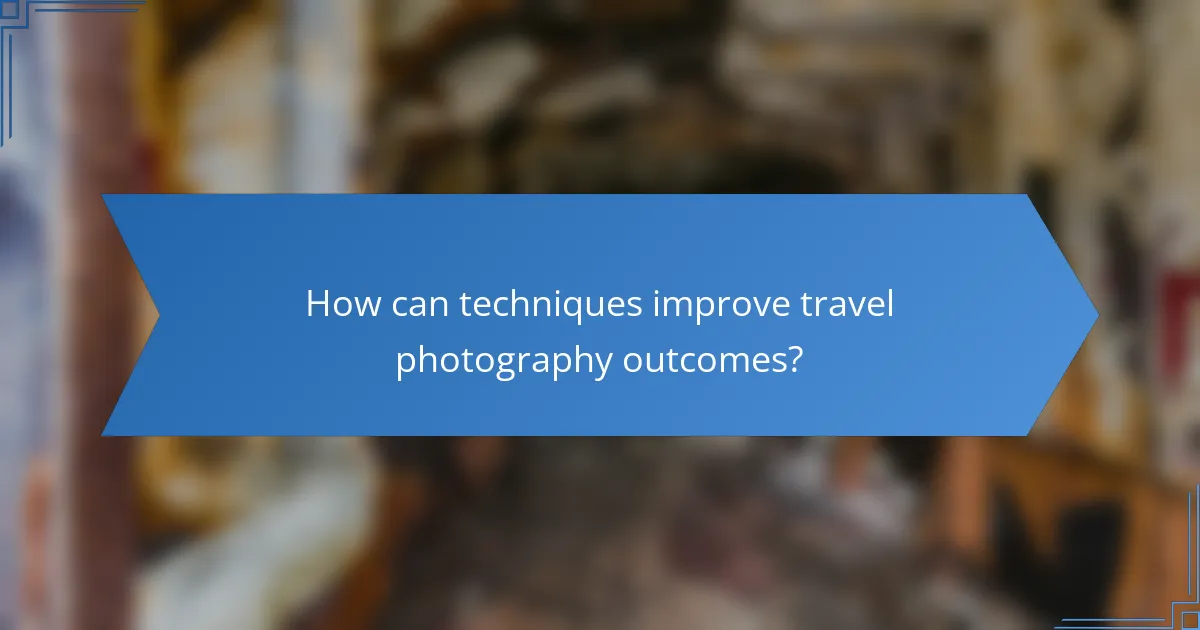
How can techniques improve travel photography outcomes?
Techniques significantly enhance travel photography outcomes by improving composition, lighting, and storytelling. Mastering techniques like the rule of thirds and leading lines elevates image quality. Understanding natural light conditions helps capture vibrant colors and details. Additionally, employing post-processing techniques refines images, making them more visually appealing. These practices ensure that photographs not only document experiences but also convey emotions and narratives effectively.
What composition strategies are effective in travel photography?
Effective composition strategies in travel photography include the rule of thirds, leading lines, and framing. These techniques enhance visual storytelling and guide the viewer’s eye. The rule of thirds divides the frame into a grid, placing subjects at intersections for balance. Leading lines draw attention to focal points, creating depth. Framing uses natural elements to enclose the subject, adding context. Mastering these strategies improves the overall impact of travel images.
How does lighting impact travel photography results?
Lighting significantly affects travel photography results by influencing mood, detail, and composition. Natural light creates depth, while harsh lighting can lead to overexposure. Golden hour, the time shortly after sunrise or before sunset, offers soft, warm tones that enhance landscapes and portraits. In contrast, midday sun often produces harsh shadows, which can detract from the subject. Understanding light quality, direction, and color temperature is essential for capturing stunning images. Proper use of lighting techniques can elevate travel photography, making it more engaging and visually appealing.
What post-processing techniques are beneficial for travel photos?
Post-processing techniques that enhance travel photos include color correction, cropping, noise reduction, and sharpening. These methods improve overall image quality and highlight unique attributes of the captured scenes. For instance, color correction adjusts hues to reflect the actual environment, while cropping can emphasize focal points. Noise reduction minimizes unwanted grain, especially in low-light conditions, and sharpening enhances details for a clearer view. Together, these techniques elevate the visual appeal of travel photography.
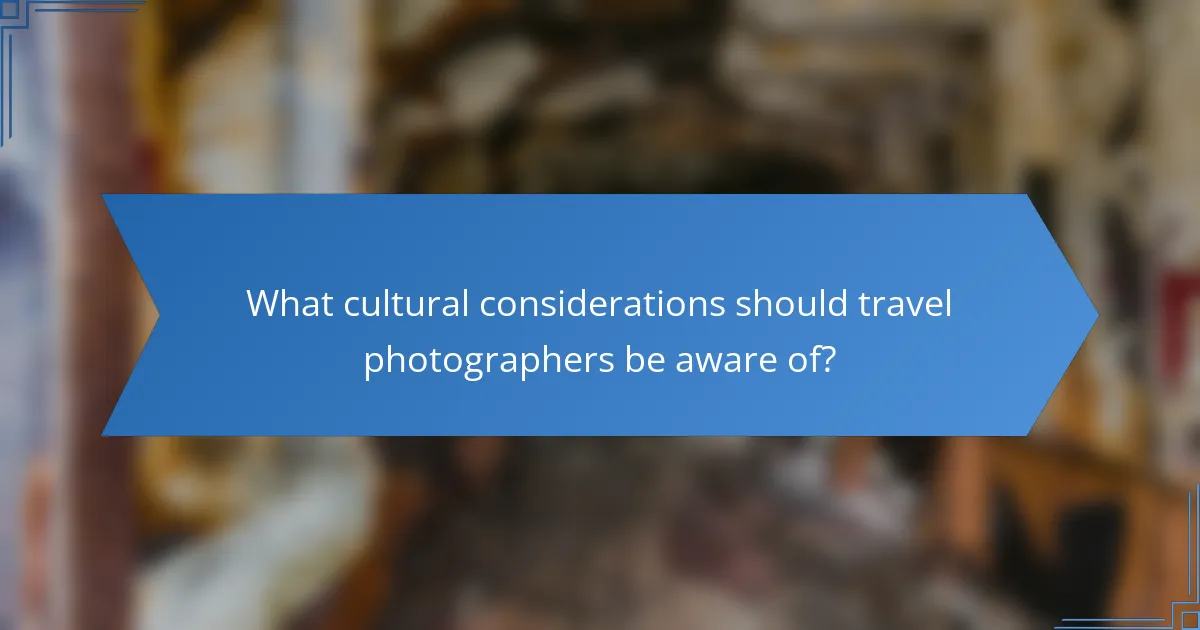
What cultural considerations should travel photographers be aware of?
Travel photographers should respect local customs, traditions, and privacy. Understanding cultural norms enhances the travel experience and fosters positive interactions.
Engaging with communities respectfully can lead to more authentic photographs. For example, always ask permission before photographing individuals, especially in sensitive situations.
Awareness of dress codes and behavior is crucial. In some cultures, modest clothing is necessary, while in others, specific gestures may hold significant meaning.
Researching local history and practices can provide deeper insights, allowing photographers to capture images that resonate with cultural significance.
How do local customs influence photography practices?
Local customs significantly shape photography practices by influencing subjects, techniques, and styles. Photographers often adapt to cultural norms, capturing local events and traditions. For example, festivals may dictate vibrant color palettes and specific compositions. Unique attributes such as local attire and rituals become focal points, enhancing storytelling in images. Additionally, customs can dictate the appropriateness of photography in certain settings, affecting the photographer’s approach and engagement with subjects. Understanding these nuances enriches the travel photography experience and fosters respect for cultural contexts.
What ethical guidelines should be followed in different cultures?
Respecting cultural norms is crucial in travel photography. Ethical guidelines vary across cultures but generally include obtaining consent, being aware of local customs, and avoiding exploitation. Photographers should engage with subjects respectfully and understand cultural sensitivities. For example, in some cultures, photographing people without permission is considered intrusive. Additionally, sharing images that misrepresent or stereotype a culture can lead to negative consequences. Understanding these guidelines fosters positive interactions and enhances the travel photography experience.
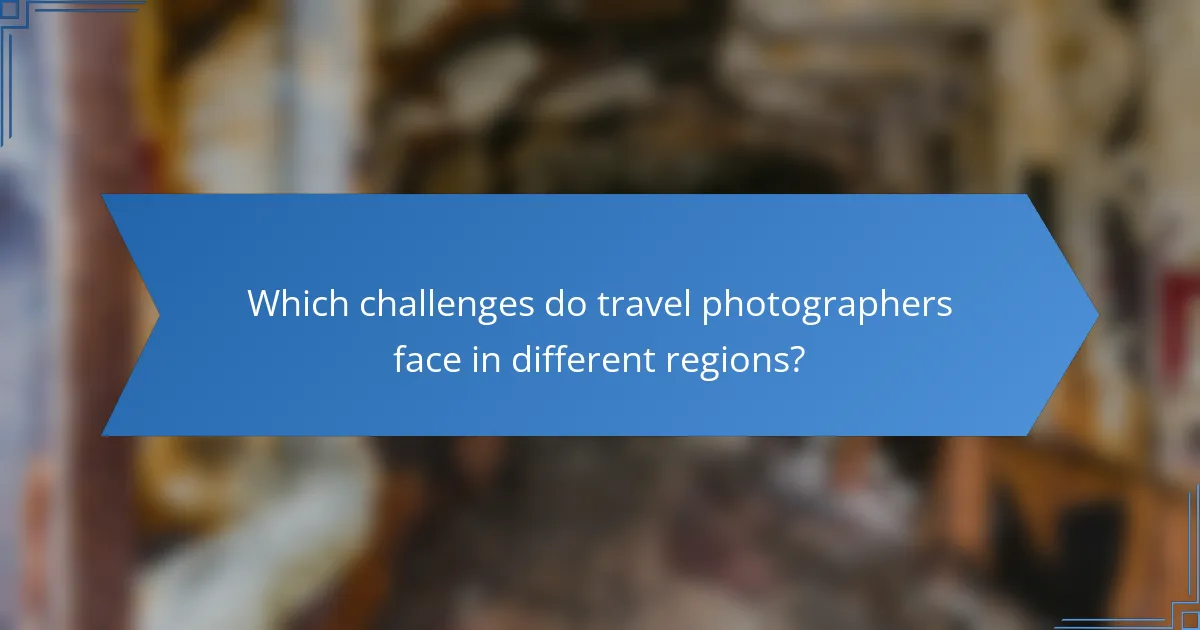
Which challenges do travel photographers face in different regions?
Travel photographers face various challenges depending on the region, including cultural differences, environmental conditions, and logistical issues. In urban areas, navigating crowds and accessing iconic locations can be difficult. In remote regions, photographers may struggle with harsh weather and limited resources. Cultural sensitivity is crucial in diverse locales, as missteps can lead to negative interactions. Additionally, equipment protection becomes essential in extreme environments, influencing the choice of gear.
What common issues arise in urban vs. rural photography?
Urban photography often faces issues like overcrowding and distractions, while rural photography deals with accessibility and lighting challenges. Urban environments may present unique attributes such as diverse subjects and dynamic settings, but they can also lead to rare problems like unwanted human elements in shots. In contrast, rural photography offers serene landscapes, yet it may have unique attributes like limited infrastructure for capturing images. Understanding these differences helps photographers choose appropriate techniques and gear for each setting.
How can photographers adapt to changing weather conditions?
Photographers can adapt to changing weather conditions by using weather-resistant gear and adjusting their shooting techniques. Carrying protective covers for cameras and lenses helps shield equipment from rain or snow. Additionally, understanding how different lighting affects photography can improve image quality in various weather scenarios. For instance, overcast days can enhance colors, while golden hour light during sunrise or sunset creates dramatic effects. Finally, planning shoots around weather forecasts ensures that photographers capture optimal conditions.

What unique storytelling techniques can enhance travel photography?
Unique storytelling techniques can significantly enhance travel photography by creating engaging narratives. Using local culture as a backdrop adds depth, while incorporating personal experiences makes images relatable. Utilizing various perspectives, such as aerial or close-up shots, can evoke different emotions. Combining visual elements with compelling captions helps convey stories effectively. Lastly, experimenting with light and shadow can create dramatic effects, enhancing the overall impact of the photograph.
How can photographers capture authentic local experiences?
Photographers can capture authentic local experiences by engaging with the community and immersing themselves in the culture. Building relationships with locals enhances storytelling through imagery.
Utilizing natural light and candid moments adds authenticity to travel photography. Equipment like a versatile lens and a lightweight camera aids in capturing spontaneous events.
Researching local customs and traditions provides context, making photographs more meaningful. Understanding cultural nuances can lead to unique perspectives that resonate with viewers.
Finally, practicing patience and respect while photographing people fosters genuine connections, resulting in more impactful images.
What role does narrative play in travel photography?
Narrative plays a crucial role in travel photography by providing context and emotional depth. It transforms simple images into compelling stories that resonate with viewers. A strong narrative can evoke feelings, convey cultural experiences, and highlight unique attributes of a destination. This storytelling aspect enhances the viewer’s connection to the photograph and fosters a deeper understanding of the culture and environment captured. Effective travel photography combines visual elements with narrative techniques, making the experience more immersive and memorable.
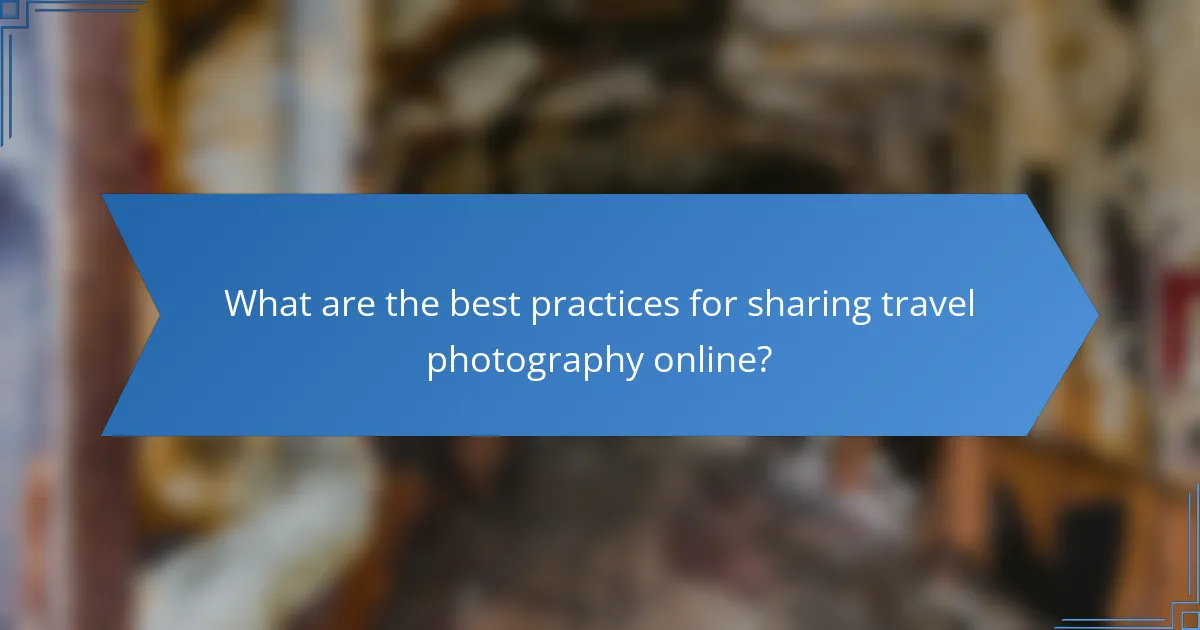
What are the best practices for sharing travel photography online?
To effectively share travel photography online, focus on high-quality images, engaging captions, and consistent branding. Use social media platforms that highlight visual content, such as Instagram and Pinterest. Engage with your audience through comments and shares to build a community around your work. Utilize relevant hashtags to increase visibility and connect with like-minded photographers. Lastly, consider the cultural context of your images to promote respectful representation of the places and people you photograph.
How can social media platforms be leveraged for travel photography?
Social media platforms can enhance travel photography by providing exposure, community engagement, and instant feedback. Photographers can showcase their work to a global audience, connect with like-minded individuals, and gain insights through real-time interactions. Platforms like Instagram and Pinterest allow users to share stunning visuals and discover new locations, enriching their travel experiences. Additionally, leveraging hashtags and geotags can increase visibility and attract followers interested in travel photography.
What are common mistakes to avoid when showcasing travel photos?
To effectively showcase travel photos, avoid common mistakes that can detract from their impact. Firstly, ensure proper lighting; poorly lit photos can obscure details. Secondly, avoid cluttered backgrounds that distract from the main subject. Thirdly, maintain focus on the subject; blurry images diminish quality. Fourthly, resist oversaturation or excessive editing, which can lead to unnatural appearances. Lastly, consider the storytelling aspect; failing to convey a narrative can lessen engagement.
What tips do experts recommend for optimizing travel photography portfolios?
Experts recommend focusing on storytelling, composition, and editing for optimizing travel photography portfolios. Showcase diverse cultural contexts through images that evoke emotions and convey unique narratives. Use high-quality gear tailored to your style, and maintain consistency in editing to create a cohesive look. Regularly update your portfolio with fresh content to reflect evolving skills and experiences.